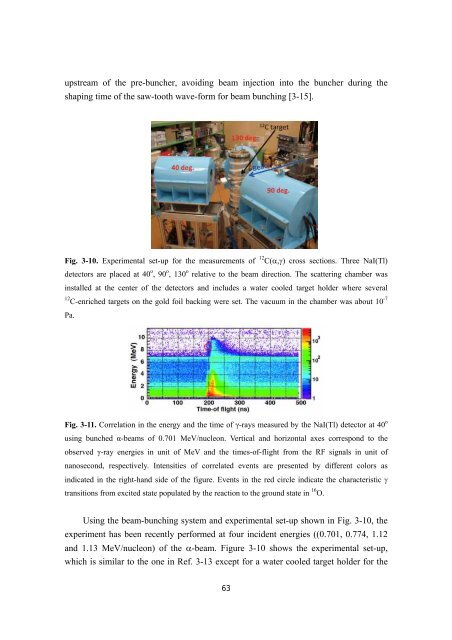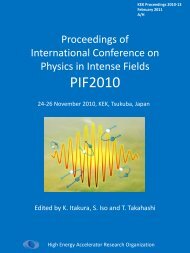TRIAC Progress Report - KEK
TRIAC Progress Report - KEK
TRIAC Progress Report - KEK
You also want an ePaper? Increase the reach of your titles
YUMPU automatically turns print PDFs into web optimized ePapers that Google loves.
upstream of the pre-buncher, avoiding beam injection into the buncher during the<br />
shaping time of the saw-tooth wave-form for beam bunching [3-15].<br />
Fig. 3-10. Experimental set-up for the measurements of 12 C(α,γ) cross sections. Three NaI(Tl)<br />
detectors are placed at 40 o , 90 o , 130 o relative to the beam direction. The scattering chamber was<br />
installed at the center of the detectors and includes a water cooled target holder where several<br />
12 C-enriched targets on the gold foil backing were set. The vacuum in the chamber was about 10 -7<br />
Pa.<br />
Fig. 3-11. Correlation in the energy and the time of γ-rays measured by the NaI(Tl) detector at 40 o<br />
using bunched α-beams of 0.701 MeV/nucleon. Vertical and horizontal axes correspond to the<br />
observed γ-ray energies in unit of MeV and the times-of-flight from the RF signals in unit of<br />
nanosecond, respectively. Intensities of correlated events are presented by different colors as<br />
indicated in the right-hand side of the figure. Events in the red circle indicate the characteristic γ<br />
transitions from excited state populated by the reaction to the ground state in 16 O.<br />
Using the beam-bunching system and experimental set-up shown in Fig. 3-10, the<br />
experiment has been recently performed at four incident energies ((0.701, 0.774, 1.12<br />
and 1.13 MeV/nucleon) of the α-beam. Figure 3-10 shows the experimental set-up,<br />
which is similar to the one in Ref. 3-13 except for a water cooled target holder for the<br />
63













